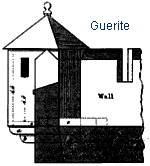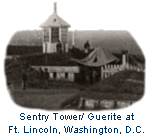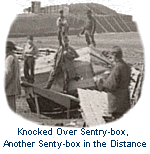 Also
called an Echauguette. In permanent fortifications a guerite was an enclosed
and loop-holed sentry-box projecting from the masonry revetment of scarp
walls at flanked angles of bastions. Its purpose was to provide a musket-proof
position where sentries could see the length of the main ditch and counterscarp.
The floor of a guerite projecting from the scarp was also loop-holed to serve
as a machicouli for defense of the flanked angle. Since guerites generally
rose above the level of the masonry scarp they tended to mark bastion salients
and make it easier for a besieging army to identify the exact direction of
bastion faces and select positions for ricochet batteries. Guerites also
inhibited defenders from establishing defensive batteries to fire along the
lines of bastion capitals. Guerites had generally fallen out of use by the
middle of the nineteenth century. Also
called an Echauguette. In permanent fortifications a guerite was an enclosed
and loop-holed sentry-box projecting from the masonry revetment of scarp
walls at flanked angles of bastions. Its purpose was to provide a musket-proof
position where sentries could see the length of the main ditch and counterscarp.
The floor of a guerite projecting from the scarp was also loop-holed to serve
as a machicouli for defense of the flanked angle. Since guerites generally
rose above the level of the masonry scarp they tended to mark bastion salients
and make it easier for a besieging army to identify the exact direction of
bastion faces and select positions for ricochet batteries. Guerites also
inhibited defenders from establishing defensive batteries to fire along the
lines of bastion capitals. Guerites had generally fallen out of use by the
middle of the nineteenth century.
 In
field fortifications sentry-boxes could be constructed in square or octoganal
shapes with peaked or leaning roofs and were usually placed on the superior
slopes of parapets to provide elevated and covered (and shaded) positions
for sentries to keep watch over the near approaches to a fortification. As
the illustration of the sentry-box at Fort Lincoln shows (to the left) these In
field fortifications sentry-boxes could be constructed in square or octoganal
shapes with peaked or leaning roofs and were usually placed on the superior
slopes of parapets to provide elevated and covered (and shaded) positions
for sentries to keep watch over the near approaches to a fortification. As
the illustration of the sentry-box at Fort Lincoln shows (to the left) these
 stuctures
could also be positioned on elevated points within a fortification and could,
when time, labor, and availability of materials allowed, reach a relatively
high state of refinement. stuctures
could also be positioned on elevated points within a fortification and could,
when time, labor, and availability of materials allowed, reach a relatively
high state of refinement. |